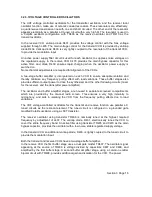
3.2.1.4.1
Path 1.
In this path the signal is first attenuated by approximately lOdB with resistors R221 and 8222
on the control board. This is to reduce the AF level into IC204 (the CTCSS decoder and high
pass filter), which requires a lower AF level for correct operation. If IC204 is not fitted the
option is bypassed by the link 8249, and the signal is then filtered by one stage of the dual OP
AMP IC201. This filter is a high pass design with a cut-off frequency of 300Hz. Following the
high pass filter is the mute gate circuit using transistors TR202 and TR203. When the
microprocessor activates these two transistors the receiver audio signal path is attenuated by
more than 70dB. The other stage of OP AMP IC201 acts as an amplifier, with R220 and C215
in the feedback loop, producing a -6dB per octave de-emphasis response.
Some high frequency attenuation above 3kHz is also obtained by the low pass filter action of
capacitor C213 and C223 in the audio path.
3.2.1.4.2
Path 2.
The second path of the demodulated received audio, is coupled from the output of IC401 pin
1, to the mute noise processing circuit. A bandpass filter/amplifier using the second stage of
IC401 is formed by the combination of L403 and capacitors C461, C462 and C463. With the
25kHz channel spacing version this frequency is 8kHz. For the 12.5kHz channel spacing
version additional amplification is required and this is provided by TR427 which has further
gain/temperature compensation with R454. The bandpass filter for 12.5kHz version is formed
by L403 and C636 at a frequency of 32kHz.
The resulting signal in this frequency band is, effectively, out-of-band demodulated noise.The
amplified noise is half-wave rectified at the output of IC401 PIN 14 by diode D426 which is
forward biased. The integrator capacitor loading the rectifier is C466. The rectifier
configuration actually provides a voltage doubling in the charging of C466.
The third stage of OP AMP IC401 is configured in a Schmitt trigger circuit which compares the
voltage across C466 to a reference voltage set by the mute pot R226B on the control board. In
the absence of the noise (ie, the receiver is quietened by an incoming signal) the inverting
input to the schmitt trigger is biassed at approximately 3 volts. The adjustment range of the
mute potentiometer provides the non-inverting input to the schmitt with a voltage between 5
and 7.5 volts. This is always greater than 3 volts, therefore the schmitt output will be high. This
schmitt output is voltage divided by D428, R463 and R464 to provide the microprocessor with
a +5v logic level to indicate "mute open". When the receiver has no input carrier, the rectified
noise increases the voltage at the schmitt inverting input to approximately 6.5volts. This level
is limited by D445 and the resistor divider network of R466, R467 and R459. The mute adjust
potentiometer may be set to cause a negative difference voltage between the two inputs of the
schmitt, in which case the schmitt output will switch low to indicate "mute close" condition.
D428 is used to ensure the microprocessor receives 0 volt for the logic low state. D427 in the
positive feedback path of the schmitt stage, begins to conduct for the low voltage settings of
the mute potentiometer, corresponding to the maximum mute position. This produces a larger
hysteresis range for the high mute opening threshold.
Section 3 Page 7






























